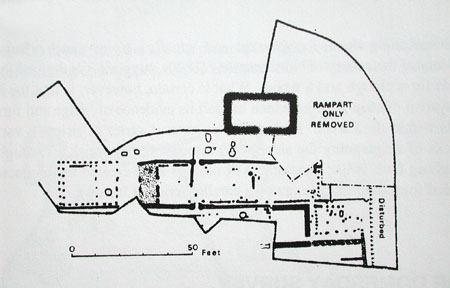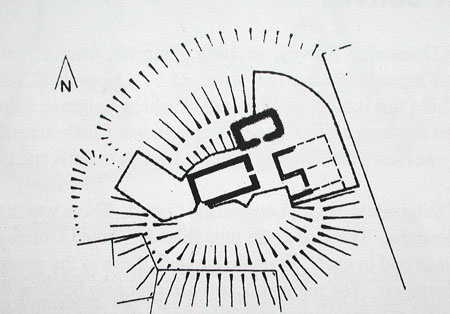
Position of Saxon Halls c. 1010 A.D.
THE SAXON HALLS
(Back to Chapter 1 Index)
Excavations took place between 1967 and 1976 which proved that the site was first inhabited about 975 AD. Thus, before becoming Ghilo's Castle, it must have been owned by a Saxon Thane. Such a person is defined as being the owner of five hides of land (600 acres), a chapel, a hall and kitchen!
The archaeological evidence suggests the site first consisted of a shallow ditch to mark the perimeter, a long narrow timber hall, a separate kitchen and probably a chapel.

Position of Saxon Halls c. 1010 A.D.

Position of Saxon Halls c. 1080 A.D.
Two finds during the excavations give us some evidence of possible happenings during these Saxon times. A silver coin of the reign of Edgar was discovered outside the castle complex but within the perimeter wall. This represents the daily wage of a fairly skilled craftsman. As the Saxons kept their coinage in boxes and only removed it for a specific purpose, this poses the question, where was the coin being taken? It has been suggested by Brian Davison, the archaeologist in charge of the excavations, that it was being transferred to the chapel as an offering. This discovery and the definition of a Thane suggest that the present church is built on the site of a Saxon chapel, which would account for the presence of a re-sited Saxon doorway in the tower wall.
At this time the Danes, who were in control of the land to the east of the Watling Street, were being paid Danegeld. In one year, they were paid £80,000! How this affected the life of the inhabitants of Sulgrave can be conjectured from the second find.
Obverse side of a coin of Aethelraed the Un-
ready, minted circa 1002 and lost shortly
after. This had been copied and made into
a brooch.
A brooch made from brass alloy which shone like gold had been hammered around a coin which was in circulation from 1009. This piece of metal had then been fastened onto a wooden disc. This could suggest that the Thane's wife had to make to with cheap jewellery instead of the normal gold and silver.
1009 was the year the Danes attacked and burned Oxford. In the following year, they burnt London and travelled up the east coast, burning Northampton on their return. This must have made the Thane of Sulgrave very nervous, for in that year he began to redesign the site.
He demolished the kitchen and shortened the hall, building a new wing with stone footings. He began an abortive attempt to dig a ditch and embankment to the west of the site but this was soon abandoned.